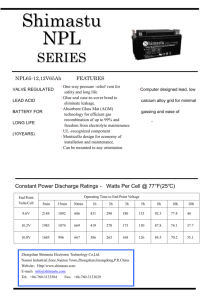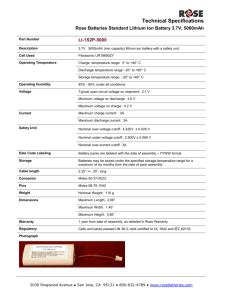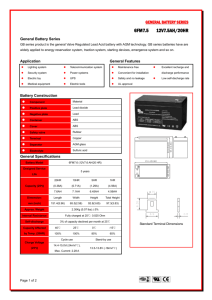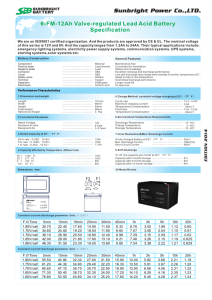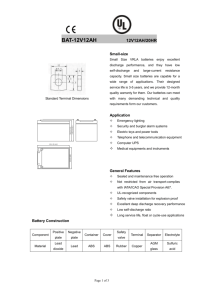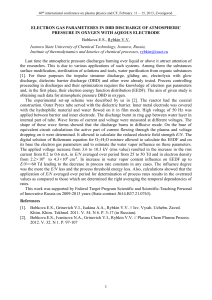Effect of Noble Gases and Water Vapor on
advertisement
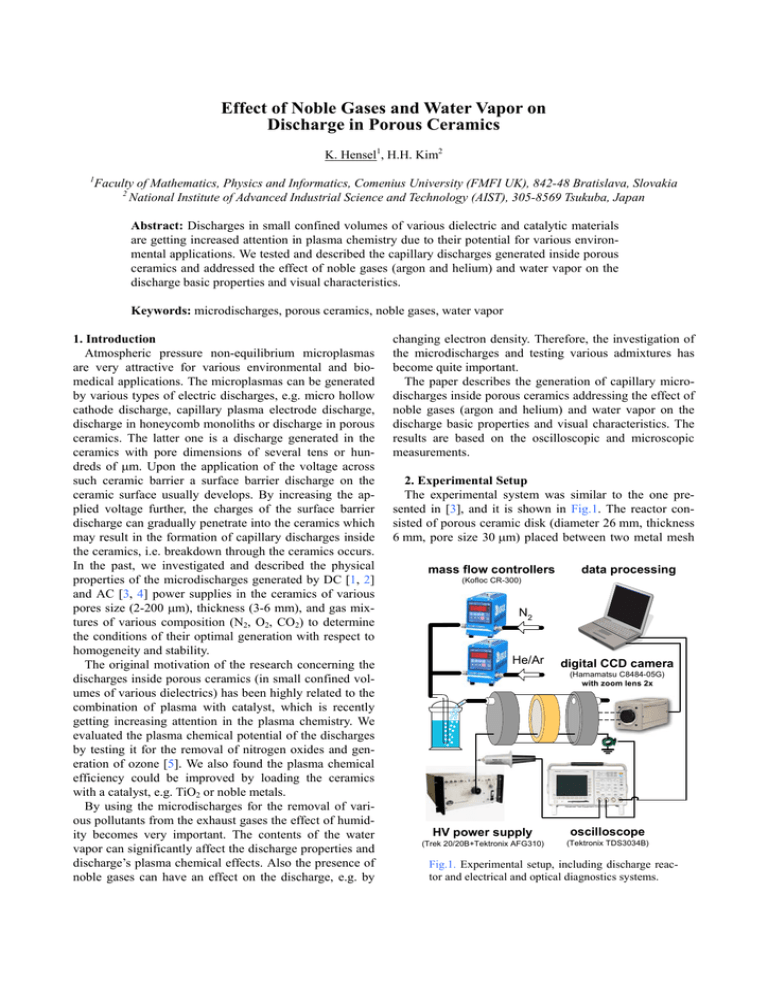
Effect of Noble Gases and Water Vapor on Discharge in Porous Ceramics K. Hensel1, H.H. Kim2 1 Faculty of Mathematics, Physics and Informatics, Comenius University (FMFI UK), 842-48 Bratislava, Slovakia 2 National Institute of Advanced Industrial Science and Technology (AIST), 305-8569 Tsukuba, Japan Abstract: Discharges in small confined volumes of various dielectric and catalytic materials are getting increased attention in plasma chemistry due to their potential for various environmental applications. We tested and described the capillary discharges generated inside porous ceramics and addressed the effect of noble gases (argon and helium) and water vapor on the discharge basic properties and visual characteristics. Keywords: microdischarges, porous ceramics, noble gases, water vapor 1. Introduction Atmospheric pressure non-equilibrium microplasmas are very attractive for various environmental and biomedical applications. The microplasmas can be generated by various types of electric discharges, e.g. micro hollow cathode discharge, capillary plasma electrode discharge, discharge in honeycomb monoliths or discharge in porous ceramics. The latter one is a discharge generated in the ceramics with pore dimensions of several tens or hundreds of μm. Upon the application of the voltage across such ceramic barrier a surface barrier discharge on the ceramic surface usually develops. By increasing the applied voltage further, the charges of the surface barrier discharge can gradually penetrate into the ceramics which may result in the formation of capillary discharges inside the ceramics, i.e. breakdown through the ceramics occurs. In the past, we investigated and described the physical properties of the microdischarges generated by DC [1, 2] and AC [3, 4] power supplies in the ceramics of various pores size (2-200 μm), thickness (3-6 mm), and gas mixtures of various composition (N2, O2, CO2) to determine the conditions of their optimal generation with respect to homogeneity and stability. The original motivation of the research concerning the discharges inside porous ceramics (in small confined volumes of various dielectrics) has been highly related to the combination of plasma with catalyst, which is recently getting increasing attention in the plasma chemistry. We evaluated the plasma chemical potential of the discharges by testing it for the removal of nitrogen oxides and generation of ozone [5]. We also found the plasma chemical efficiency could be improved by loading the ceramics with a catalyst, e.g. TiO2 or noble metals. By using the microdischarges for the removal of various pollutants from the exhaust gases the effect of humidity becomes very important. The contents of the water vapor can significantly affect the discharge properties and discharge’s plasma chemical effects. Also the presence of noble gases can have an effect on the discharge, e.g. by changing electron density. Therefore, the investigation of the microdischarges and testing various admixtures has become quite important. The paper describes the generation of capillary microdischarges inside porous ceramics addressing the effect of noble gases (argon and helium) and water vapor on the discharge basic properties and visual characteristics. The results are based on the oscilloscopic and microscopic measurements. 2. Experimental Setup The experimental system was similar to the one presented in [3], and it is shown in Fig.1. The reactor consisted of porous ceramic disk (diameter 26 mm, thickness 6 mm, pore size 30 μm) placed between two metal mesh mass flow controllers data processing (Kofloc CR-300) N2 He/Ar digital CCD camera (Hamamatsu C8484-05G) with zoom lens 2x HV power supply oscilloscope (Trek 20/20B+Tektronix AFG310) (Tektronix TDS3034B) Fig.1. Experimental setup, including discharge reactor and electrical and optical diagnostics systems. 3.1. Noble Gases We investigated the effects of noble gases on the discharge onset voltage, amplitude of the current pulses and pulse repetition rate. The capillary microdischarges generated inside porous ceramics are spark discharges, which originate from a surface barrier discharge on the ceramic surface above a certain applied voltage. It was found that with the increasing amount of noble gases in nitrogen, the microdischarge onset voltage (U0) decreased (Fig. 2). The decrease of the onset voltage was more prominent in case of Ar compared with He. The decrease of the onset voltage and direct spark breakdown in Ar compared with mixtures with nitrogen can most probably be attributed to free-electron properties of noble gases [6]. Figure 3 shows that by increasing the applied voltage gradually above the onset voltage the amplitude of the discharge current pulses (IA), as well as, the mean discharge current increased. At the given applied voltage, the amplitude of the current pulses was found independent of the partial concentrations of noble gases. Together with the amplitude of the pulses we also monitored the average delay (Iτ) between two consecutive pulses (pulse repetition rate). Figure 4 shows the delay decreased with the applied voltage. In contrast to the amplitude, at the given applied voltage, however, the delay was not found independent of the concentration of noble gases. The figure shows that the delay decreased with increasing amount of noble gases. The increasing repetition rate of the pulses resulted into improved homogeneity of the discharge spatial distribution inside the ceramics, especially at concentration of 60 and 80% of Ar. Comparing the results obtained for Ar and He, we found that at the given applied voltage the amplitude of the current pulses was higher in He. For example, at 80% of Ar/He partial concentration, the amplitude in He was higher by 50-60%. The differ- He 12 Ar UO [kV] 10 8 6 4 2 0 0 20 40 60 Ar/He [%] 80 100 Fig.2. Capillary microdischarge onset as function of partial concentration of Ar or He in N2. 40 0% 20% 40% 60% 80% 100% 30 IA [A] 3. Results and Discussion The results demonstrate various effects of noble gases and water vapor on electrical and optical characteristics of the microdischarges. 14 20 10 0 0 5 10 15 20 U [kV] Fig.3. Current pulse amplitude as function of applied voltage and partial concentration of Ar in N2. 400 0% 20% 40% 60% 80% 100% 300 Iτ [μ s] electrodes and enclosed in a sealed glass cylinder. The reactor was powered by AC high voltage power supply equipped with an amplifier (Trek 20/20B) and a function generator (Tektronix AFG 310). The current (Pearson Electronics 2877) and voltage probes (Tektronix P6015A) connected to the oscilloscope (Tektronix TDS3034B) were employed for discharge current and voltage measurements, and digital CCD camera (Hamamatsu C8484-05G) equipped with a set of lenses for microscopic observations of the generated microdischarges. Various mixtures of Ar, He (up to 100%) and water vapors (up to 2.6%) in nitrogen balance with the total gas flow 1L/min were tested. All experiments were performed at atmospheric pressure and room temperature. 200 100 0 0 5 10 U [kV] 15 20 Fig.4. Delay between the pulses as function of applied voltage and partial concentration of Ar in N2. 10 kV 14 11 kV 13 12 kV 13 kV UO [kV] 2 mm 12 11 H2O 10 0 Fig.5. Effect of applied voltage on microdischarges [40% Ar in N2, exposure time 2 ms]. 3.2. Water Vapor The effect water vapor was investigated in the same way as the effects of noble gases. Generally the effect of water was found more significant than that of noble gases. By passing a gas mixture enriched by water vapors through the porous ceramics for several minutes prior the application of the voltage caused the significant increase of the onset voltage. The effect became prominent when diminishing pore size of the ceramics (for 30μm and be- 2 3 H2O [%] Fig.6. Capillary microdischarge onset as function of concentration of H2O in N2. Fig.7. Effect of water on microdischarges formation [2.6% H2O in N2, exposure time 2 ms]. 40 300 0.25% 0.50% 1.00% 1.70% 2.60% 200 Iτ [μ s] 30 IA [A] ence between the amplitudes decreased with decreasing the partial concentration of noble gases in nitrogen balance. The optical observations by the CCD camera equipped with the microscope were performed together with the electrical measurements. Figure 5 shows the effect of the applied voltage on the discharge. The number of discharges generated per time unit (exposure time) increased with the applied voltage. While at low voltages (below 11 kV) only the surface barrier discharge was observed, with increasing voltage the capillary discharges gradually developed and became dominant. As the figure show, with the increase of the voltage the number of discharge channels increased. It corresponds to the decrease of the delay between the discharge pulses with the voltage, which was demonstrated in Fig. 4. The microscopic measurements showed also differences between discharges generated with various frequencies of the AC applied voltage. By increasing the frequency up to 500 Hz, the emission intensity of the barrier discharge significantly increased. Homogeneity of the spatial distribution of the microdischarges inside the ceramics decreased with increasing partial concentration of noble gases. In pure Ar and He, the discharges occurred only at the sharp circumference of the mesh electrodes, and no visible light emission occurred in the central part of the disk. Similar effects, regarding the onset voltage and discharge homogeneity, were also observed when using oxygen or carbon dioxide in nitrogen balance [3, 7]. 1 20 100 10 0 0 10 12 14 16 U [kV] Fig.8. Current pulse amplitude and delay between the pulses as function of applied voltage and partial concentration of H2O. low) and increasing the contents of the water vapor in the gas mixtures. Figure 6 shows the effect of the water vapor on the onset voltage. The contents of water vapor up to approximately 0.5% reduced the onset voltage. Then, with further increase of the water vapor, the onset voltage increased. The initial decrease of the onset voltage can be partially explained by the increase of surface conductivity of the ceramics. The following increase can be attributed to the well-known electron scavenging effect caused of water vapor. The ion mobility in the discharge drift region decreased with increased humidity due to the clustering mechanism. It leaded to decrease of the discharge current for the given applied voltage and therefore the decrease of the onset voltage. Water vapor condensated and accumulated inside the pores. It hindered the penetration of the charges of the barrier discharge into the ceramics and resulted into an increase of the onset voltage during the first second after the application of the voltage. The effect is shown on the images in Fig.7. Both images were taken with the same applied voltage (approx. 14 kV), but at different time. The left image was taken right after the voltage application, while the second image was taken 2-3 minutes later. The images show that the surface barrier discharge formed first but vanished in time and was supplemented by the capillary microdischarges as the effect of water decreased. In the range of investigated concentrations of water vapor (0-2.6%) we found no significant effect of water on the amplitude of the discharge current pulses (IA). At the given applied voltage, however, the delay Iτ was found decreasing with increasing water contents (Fig. 8). 4. Conclusions The effect of argon, helium and water vapor on the basic properties and visual characteristics of the capillary microdischarges inside porous ceramics were investigated. The results showed that the presence of noble gases in mixtures with nitrogen rapidly reduced the onset voltage, but fairly affected the amplitude of the discharge current pulses. Noble gases improved homogeneity of the discharge spatial distribution, especially at 60~80% of Ar. Increasing the frequency of the applied voltage, the emission intensity of the barrier discharge increased, but no effect on capillary microdischarges was observed. The effect of water vapor was found also significant. With increasing humidity, first a decrease of the onset caused by the increased conductivity of the ceramics was observed, followed by the subsequent increase caused by the electron scavenging effect. Water accumulated inside the pores and hindered the penetration of the charges of the barrier discharge into the ceramics and thus strongly affected the results. The research has been supported partially by the Slovak Grant Agency VEGA 1/0711/09. References [1] K. Hensel, Y. Matsui, S. Katsura, A. Mizuno, Czech. J. Phys. 54, C683 (2004). [2] K. Hensel, S. Katsura, A. Mizuno, IEEE Trans. Plasma Sci. 33, 574 (2005). [3] K. Hensel, V. Martišovitš, Z. Machala, et al., Plasma Process. Polym. 4, 682 (2007). [4] K. Hensel, P. Tardiveau, IEEE Trans. Plasma Sci. 36, 980 (2008). [5] K. Hensel, Z. Machala, P. Tardiveau, Eur. Phys. J. Appl. Phys. 47 (2), 22813 (2009). [6] R.S. Sigmond, M. Goldman, Corona Discharge Physics and Applications, in Electrical Breakdown and Discharges in Gases, ed. E. E. Kunhardt, L.H. Luessen (1981). [7] K. Hensel, Eur. Phys. J. D, DOI: 10.1140/epjd/e200900073-1 (2009).
